In the thirty-plus years Aura Imaging and aura image photography has been around, we’ve had our fair share of news articles written about us by true believers and curious spectators alike. Here is but a small sample of what has been said about us in our auraphoto blog… maybe you’ll learn something new in the process!
The human aura has only been seen by psychics, mystics, and saints—until now! The new aura cameras allow the aura to be photographed.
Known over the centuries by many names—chi, prana. karnaeem, and illiaster—auras have been documented for more than 5,000 years. Howard and Dorothy Sun, in their acclaimed work Color Your Life, propose that auric energies vibrate around all living things. These energies, they state, absorb sun and atmospheric light, dividing light (much as a prism does) into “component color energies” (red, orange, yellow, green, turquoise, blue, purple, and pink). Color energies are then directed toward the ethereal body’s sense organs, or energy centers, the chakras. These energy centers, say the Suns, are “power points in the body through which energy flows and is transformed.” Chakras, therefore, transform and balance the energy currents coming from the higher, finer energy fields so the material body can use this energy.
Auric fields include Etheric, Emotional, Mental, Astral, Etheric Template, Celestial, and Ketheric. According to Hands of Light by Barbara Ann Brennan. these energy fields reflect the state of health of the being they surround. When the auric fields become unbalanced, reflecting an unhealthy or uncomfortable physical or mental state, it is possible to reorganize and heal them by clearing the unhealthy or blocked energies. To accomplish this, auric fields must first be seen. Although visible to some psychics and mystics, auras remain invisible to the average person. Therefore, researchers have attempted to devise machines that will photograph and analyze the aura, then diagnose its condition.
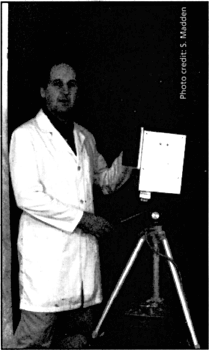
Guy Coggins with his Aura Camera 3000, a device that perceives auras electronically.
Auric fields include Etheric, Emotional, Mental, Astral, Etheric Template, Celestial, and Ketheric. According to Hands of Light by Barbara Ann Brennan. these energy fields reflect the state of health of the being they surround. When the auric fields become unbalanced, reflecting an unhealthy or uncomfortable physical or mental state, it is possible to reorganize and heal them by clearing the unhealthy or blocked energies. To accomplish this, auric fields must first be seen. Although visible to some psychics and mystics, auras remain invisible to the average person. Therefore, researchers have attempted to devise machines that will photograph and analyze the aura, then diagnose its condition.
Since the 1890s, when the first aura photograph was taken by Nicola Tesla, the search has succeeded in producing mostly fraud, poor-quality prints, and small, direct-contact energy prints known as Kirlian photographs.
Using cutting-edge technology, researchers can now observe and photograph auric fields without direct contact with the photographic plate.
The introduction of aura cameras makes possible the relatively effortless recording of these colorful luminous formations. More advanced than Tesla’s early attempts or those of Semyon and Valentina Kirlian, aura-imaging photography produces full spectrum color prints of bioplasmic energy transfer. The resulting pictures show the upper segment of the body, including the shoulder, neck, and head region. This region is photographed for two reasons. First, more auric activity seems to take place in this section of the body. Second, filming a small section of the body provides better visual observations of color, shapes, variations, and distributions.
The new aura cameras use a power source that charges the subject’s body with electrical energy. This energy is picked up by probes and electronically converted into an aura image, which is then recorded by the camera. The camera displays the aura as colorful fields of light, providing the therapist or healer with quick recognition of shape, color, and size, and quick processing (each color suggests a specific physical, emotional, or spiritual condition). Simply speaking, conditions and their corresponding colors include passionate and joyful red, happy and creative orange, disciplined yellow, healing green, sensitive and solitary blue, relaxing violet, and spiritual white.
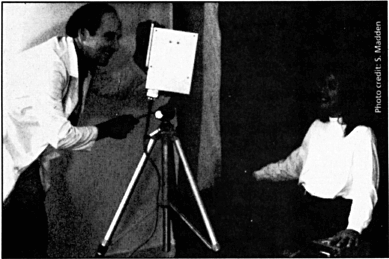
Coggins demonstrates his camera, one of the newest of a
new breed of aura imaging devices.
The Aura Camera 3000
One innovator in aura-imaging technology, Guy Coggins, is the inventor of the AuraCamera 6000, introduced in 1992. This camera represents a major step in biofeedback imaging. The aura camera, according to its inventor, does not see auras: rather it perceives them electronically, using a computer program to convert energy impulses into an auric image. These images can then be viewed on a projection screen or printed on photographic paper, creating a permanent record.
Two methods are used in aura photography. One is a video method that uses an antenna grid (a sequential series of 100 x 100 radio receiving antennas, each capable of picking up signals closest to it) placed behind the subject upon whom energy is transmitted. Johannes Fisslinger’s new work Aura Imaging Photography presents a vivid description of this:
“The screen is alive with colors, and they change wildly as she [the subject] plays a simple game of computer tic tac toe. In front of us is an ordinary chair placed in front of a movie screen with a video projector focused on the screen at the other side of the room. [The antenna grid is behind the chair.] “One of the technicians in a white lab coat asks me if I would like to see my aura, and [she] motions me to the chair. I sit down, place my hands on the two sensors looking like something out of a movie: two polished white pedestals covered with many small metal strips formed to exactly fit my hand. I then look into an ordinary mirror at the other end of the room and see my reflection with gorgeous bands of the brilliant color yellow. The computer’s loudspeaker says in a [machine-like] voice, ‘Yellow, very intellectual,’ and then becomes quiet.” The second technique, using hand probes, simultaneously measures electromagnetic energy levels at various acupuncture points on hands. These points correspond to different parts of the physical and auric bodies.
About the invention
According to Coggins, the Aura Camera 3000, and others like it, “transmits radio waves through the subject’s electromagnetic field, then converts the waves into electrical energy that can be processed…as light and color.” While sitting, the subject is asked to place his or her left and right hand on a probe that transmits a mild electric current through the subject. The subject’s body then begins emitting radio waves.
Coggins says that the subject’s body becomes a “living antenna” transmitter. The energy produced by this human antenna is, in turn, received by a complex series of receiver-scanners located in an array behind the subject (the antenna grid). Each probe has a unique receiver wired through a high-speed multiplexer (a device that converts information from the antenna grid to a computer, where it is processed and displayed as electromagnetic energy—i.e., light and sound—or the aura).
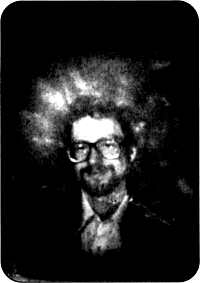
Aura healers
Aura photography is being used by healers, therapists, biofeedback centers, New Age expos, meditation retreats, and private health and medical practices. Aura cameras provide practitioners with yet another tool for evaluating thier clients physiological and psychological natures. The camera, as in Kir-Han techniques, can record traits of interpersonal relationships (i.e., sexual attraction, hate, disinterest, and personalities).
The concept behind this is that when two people who like each other touch, their skin resistance drops. On the other hand, when people who have no emotional attraction touch, skin resistance increases and a barrier (an energy line, appearing as a bright section of light on an aura photograph) is formed.
Individuals may be photographed together, touching. Or they may be photographed separately while thinking of each other. The photographs are then compared. Analysis of the auras can shed light on the state of the couple’s relationship.
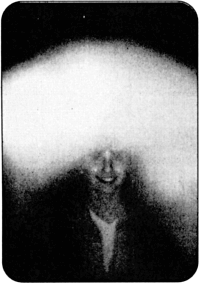
An article on Kirlian photography that appeared in the German magazine Esotera, sheds light on this, with a case study. In this study, a woman and a man were asked to place their fingers close together and have a picture taken by the Kirlian apparatus. The photograph was retaken for three successive weeks.
The initial picture showed that the man was attracted to the woman (strong, bright red and blue corona). The female corona, however, revealed that the woman was disinterested. In the photograph, her corona attempted to form an energy barrier between her electrical field and his.
The man’s corona changed in shape and size (larger, more intense) showing his persistence, by the second week. The female’s corona barrier lessened and began to show signs of red-orange (desire or pleasure), meaning that the woman was becoming more responsive to the man’s advances.
Finally, in the third week, the photograph showed two healthy, bright coronas, full of red, blue, and white— blending together. The article states that the couple are living “happy ever after.”
Using the same principles, the aura camera can be used as an alternative diagnostic tool. Like the small Kirlian photos, aura photographs can also show “comparative differences and improvements in a client’s energy field with before and after photos taken during healing and counseling sessions.” In these therapy sessions, the holistic healer takes a client’s photograph as soon as he or she enters the office and again at the end of the healing session. Changes, reflecting the healing session’s effect, should be evident.
Scientists have been curious about auras for decades, many of them believing that auras are psychic phenomena observable only by sensitive psychics, while others believe they are material phenomena that can be objectively observed if only the right tools are found. (Some, of course, believe that they are simple electrical discharge without any larger meaning.)
Researching the aura
One of the earliest scientific investigations of auric formations was conducted by Walter J. Kilner, a physician at St. Thomas’ Hospital in London. By cementing two pieces of glass around the edges except for one small opening, pouring a bluish dye called dicyanin (coal-tar dye from Germany) into the hollow glass, and then sealing it, Kilner invented an apparatus that was sensitive to the ultraviolet energy spectrum. Kilner could then observe, by peering through this lens, vaporous energy (auras) extending from living bodies.
According to Kilner, the longer one looks through the blue-colored lens, the more sensitive the eyes become to ultraviolet and higher-light spectrums. It is in this range that Kilner believed auras occur.
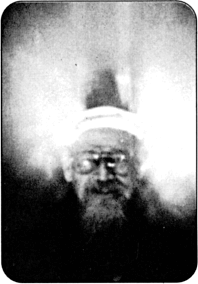
In his aura photo book, The Human Atmosphere (1911), Dr. Kilner describes a series of experiments that the reader can try. The only drawbacks to Kilner’s method are the extreme difficulty in obtaining the blue dye and the potential of serious injury to skin or eyes if the apparatus leaks.
In 1937, Oscar Bagnall, in his work The Origin and Properties of the Human Aura, expanded on Kilner’s theory. In this work, Bagnall presents a similar method of observing auric formations, but he substituted the dye pinacyanol, dissolved in triethanol-amine, for dicyanin.
In 1946, Harry Boddington, in his aura image book contents, The University of Spiritualism, announced that he had discovered a method of viewing auras through glass tinted to the same spectroscopic color as dicyanin. This glass, produced in Czechoslovakia, provides the user With a safe, permanently colored viewing lens.
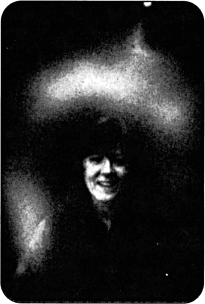
A tool to prove auric existence
Richard Gerber writes in Vibra-tional Medicine (1988) that the search for a scientific tool to prove auric existence also includes research by Valerie Hunt, a professor at the University of California. Dr. Hunt, during the 1970s, devised a technique wherein standard EMG electrodes were used to study changes in bioelectrical energy in segments of the derma (skin) approximating chakra locations. Dr. Hunt found that color variations in the aura as observed by psychics correspond with EMG recordings.
Other scientific evidence substantiating the existence of the Chakra-nadir system (energy transformers) can be found in a series of tests conducted by Dr. Hiroshi Motoyama. Motoyama was able to measure the bioelectrical field of psychics, occultists, and others who had activated a specific chakra during spiritual enlightenment or meditation. The results, according to Dr. Gerber, were that “the amplitude and frequency of the electric field over the chakra being concentrated upon was significantly greater than the energy recorded from chakras of control subjects.”
There is much evidence supporting the existence of auras that reflect the status of the body’s various electrical energy fields. Attempts to photograph these invisible auras were, until recently, limited to Kirlian photography, which is capable of revealing the presence of energy being produced by the body.
Kirlian photography, originally developed by Semyon and Valentina Kirlian, uses a high voltage alternating current field between two metal condenser plates. Color strip film is placed between the plates. The subject places a fingertip on the condenser-like plate. The technique is, therefore, limited, because the sample (subject’s fingertip) must be in contact with the electronic grid and film source. This also results in a relatively small photographic area (most commonly, only a finger tip or toe, or, if sheet film is used, a hand).
As the overhead lights are dimmed, a bright, ghostly, blue light rises from the plate area and the strong odor of ozone, produced by low ampere high electrical voltage, fills the room. The pad produces a crackling sound as electrical current is transferred from the plate to the subject’s finger. Small tentacles of white and bluish light jump in arcs, lighting the space between the skin tissue and cold metal. Once the photograph is developed, the print depicts an array of brightly colored lights extending from the fingertip. Portions of the print will be dark, while a series of blue, hairlike strands of current-induced lights extending outward are revealed on others.
Still other portions may show a bright red and orange light surrounding or extending from the figure, perhaps forming a brightly colored cornea. All of these variations in color tell the trained interpreter something specific about the subject’s state of auric health.
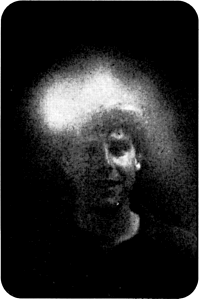
Kirlian phenomena evaluated
According to Stan Krippner and Daniel Rubin’s Galaxies of Life, researchers are divided in their evaluation of the Kirlian phenomena. Some describe the manifestation as corona discharge and believe that the technique consists only of commonplace electrical discharges affecting the print of the picture. Others believe that this technique actually reveals the bioplas-ma body or aura.
The new aura-imaging cameras have not been as thoroughly studied as has Kirlian photography. But Guy Coggins states that many tests have been conducted where psychics have observed the aura field and written down their assessment before an aura photograph was taken. In nearly every case, he says, the photograph correlated with the colors and configuration of the observed aura.
Although Coggins believes that the “camera will pass a double-blind test,” such rigid scientific scrutiny, by university or government agencies, has not yet been conducted. In the meantime, aura-imaging research has, through extensive use in the U.S. and Europe, demonstrated exciting evidence of auric or electromagnetic energy field changes.
Dr. Carl E. Lindgren has over 20 years of experience in photography. In addition, he holds masters’ degrees in Medieval history and education and a doctorate in educational history.
He has written three books and numerous magazine articles. He has traveled widely in the U.S., England, and India with his one-man photographic shows and exhibitions.
Dr. Lindgren currently works as an educationist, antiquarian, and landscape photographer. He resides in Court/and, MS, and works at the University of Mississippi.

